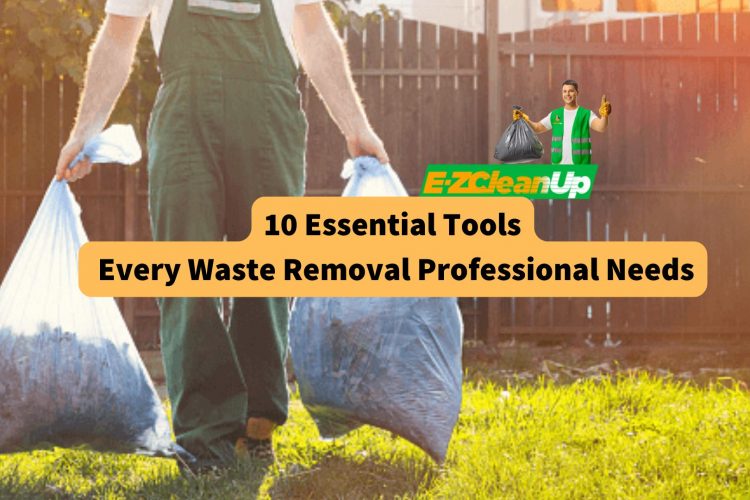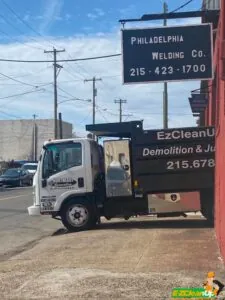Waste removal professionals need the right tools to do their job effectively. These 10 essential tools can help guarantee that tasks are completed safely, efficiently, and on time. From heavy-duty equipment to safety gear, these proper tools are crucial for managing and removing waste.
For more details on the 10 essential tools every waste removal professional needs, you can check out this article.
#1 10 Essential Tools for Waste Removal Professionals
Here are ten must-have tools for success in this field:
1. Heavy-Duty Gloves: Protect Against Unexpected Hazards
Waste removal work involves:
- handling sharp edges
- hazardous chemicals
- rough materials
Nitrile gloves can help protect against oils and chemicals, while leather gloves shield from rough surfaces. For extended tasks, you can use gloves with sweat-wicking liners for comfort. Then, layer nitrile gloves for extra protection with biohazards. You can also try to keep different types of gloves available for various tasks.
These gloves can help protect you against adhesives on construction sites, while leather gloves offer safety when lifting splintered wood.
2. Industrial-Grade Trash Bags: Made for Tough Conditions
Standard bags often tear under heavy loads, which can cause spills and waste all the effort.
Contractor-grade bags are made from durable polyethylene. They are ideal for tough tasks like:
- holding glass
- scrap metal
- heavy debris
To maximize the performance, you can cushion sharp or heavy items with softer materials, while double-bag puncture-prone items. You can try using bags with reinforced seams for jagged debris.
During a remodel, contractor-grade bags are best paired with a sturdy trash bin to help avoid spills, especially when clearing tiles.
3. Durable Shovels: Simplify Every Scoop
A high-quality shovel is another important item for handling debris.
Flat-edged shovels work well for scraping smaller materials, while scooped models handle bulkier waste like soil or sawdust. Likewise, shovels with tempered steel blades offer durability, and fiberglass handles can help reduce strain.
For precision tasks, you can use trenching tools. You can also use snow shovels for lightweight materials. Moreover, choosing durable blades and lightweight handles can help reduce fatigue.
A flat-edged shovel can also help speed up clearing adhesive from a concrete floor when compared to handheld tools.
4. Reliable Dolly or Hand Truck: Move Heavy Items Without Strain
Heavy lifting can lead to injury or wasted energy, but a dolly or hand truck helps move bulky items like furniture or debris bags with less strain.
Models with pneumatic tires work well on uneven surfaces, and its foldable design can help save space. Furthermore, you can secure your loads with straps, use stair-climbing models for steps, and go on rough ground.
A dolly with ratchet straps can also help move desks and filing cabinets during an office cleanup–safely and much easier.
5. Adjustable Wrenches: Dismantle with Precision
An adjustable wrench is perfect for breaking down furniture, fixtures, or machinery–as it fits various fasteners.
Its ergonomic grips also help reduce strain, and its precision jaws guarantee a secure grip on stubborn bolts. You can use lubricating spray for rusted fasteners and use ratcheting wrenches for tough, tight spaces.
When dismantling a kitchen during a remodeling, it’ll be quicker and easier with just one adjustable wrench.
6. Dust Masks and Respirators: Shield Against Invisible Risks
Airborne dust, mold, and fumes pose hidden risks in waste removal work. Dust masks can help protect against larger particles like sawdust, while respirators with carbon filters can block smaller contaminants and harmful fumes.
These reusable respirators with replaceable filters are also cost-effective and eco-friendly.
To choose the right mask, ensure a snug fit by checking the seal. You can do this by gently inhaling to confirm that no air can escape.
N95 or higher-rated masks are recommended for hazardous environments, while the reusable options are best on long-term projects to save costs.
Using a reusable respirator can also help guarantee safe work in a moldy basement, and prevent respiratory issues during extended cleaning.
7. LED Flashlights and Headlamps: Light the Way in Dim Spaces
Cleanup projects often take place in dark areas like:
- basements
- attics
- storage rooms
These powerful LED headlamps can allow workers for hands-free work, while handheld models offer more focused, powerful lighting.
Rechargeable lights are also cost-effective and eco-friendly. You can look for adjustable brightness, magnetic or clip-on mounts, and rechargeable batteries.
It’s beneficial to use a headlamp when cleaning an attic, as it frees up both hands for sorting through tight spaces.
8. Utility Knives and Cutters: Cut Through Obstacles
A utility knife is a versatile tool in waste removal, which is perfect for tasks like trimming plastic sheeting or dismantling boxes.
The retractable designs and titanium-coated blades provide durability and safety for tough materials. If you want to go for quality pliers and wire cutters, products from Maun offer a reliable performance.
You can also keep replacement blades on hand to avoid delays. Furthermore, these wire cutters and pliers are great for cutting wire into smaller, easier-to-handle pieces.
A utility knife can also help break down large cardboard for quick recycling, which can eventually reduce clutter and save time.
9. High-Quality Brooms and Dustpans: Tidy as You Go
Brooms are key for quick and effective cleanup. Some brooms can handle large messes, while smaller, angled brooms are great for tight corners. Together with a dustpan with a rubber lip, it helps catch finer particles.
To tackle messes efficiently, you can also use a vacuum for fine debris like drywall dust. Likewise, try choosing brooms with adjustable handles. These products are ideal for avoiding back strain during long cleaning sessions.
After a woodworking project, a stiff-bristle push broom and deep dustpan can help clean up sawdust and stray nails much faster.
10. Portable Trash Compactors: Save Space, Time, and Effort
Bulky waste can quickly fill hauling vehicles or dumpsters, but a trash compactor helps compress debris, which can save space and reduce disposal trips.
Hydraulic models can also offer extra compression power while staying portable.
To use a compactor efficiently, first, layer softer materials under dense debris for better compression. Second, you can choose a model that works with your hauling system. Also, try to give your compactor regular maintenance to guarantee long-term use.
When compacting waste during a large office cleanup, the process can help cut disposal trips by nearly half, which saves time and transportation costs.
#2 FAQs
How do I prevent waste from spilling during transportation?
Use bags or containers that are reinforced or designed to handle heavy, bulky items to minimize the risk of spillage.
Are there compact tools for waste removal in small spaces?
Yes, compact tools such as mini hand trucks, small-scale shovels, and collapsible containers are great for limited space.
How can I ensure I’m using the right tool for the job?
Always assess the materials you’re dealing with and choose tools based on their compatibility with the waste type (sharp, heavy, or bulky).
#3 The Bottom Line – Select the Right Tools for Efficient and Safe Waste Removal
Having the right tools is key to making waste removal tasks faster, safer, and more efficient. Each tool serves a specific purpose to help you handle different types of debris with ease.
By investing in quality equipment and using it correctly, you can streamline your work, reduce physical strain, and ensure safer, more effective waste management.













